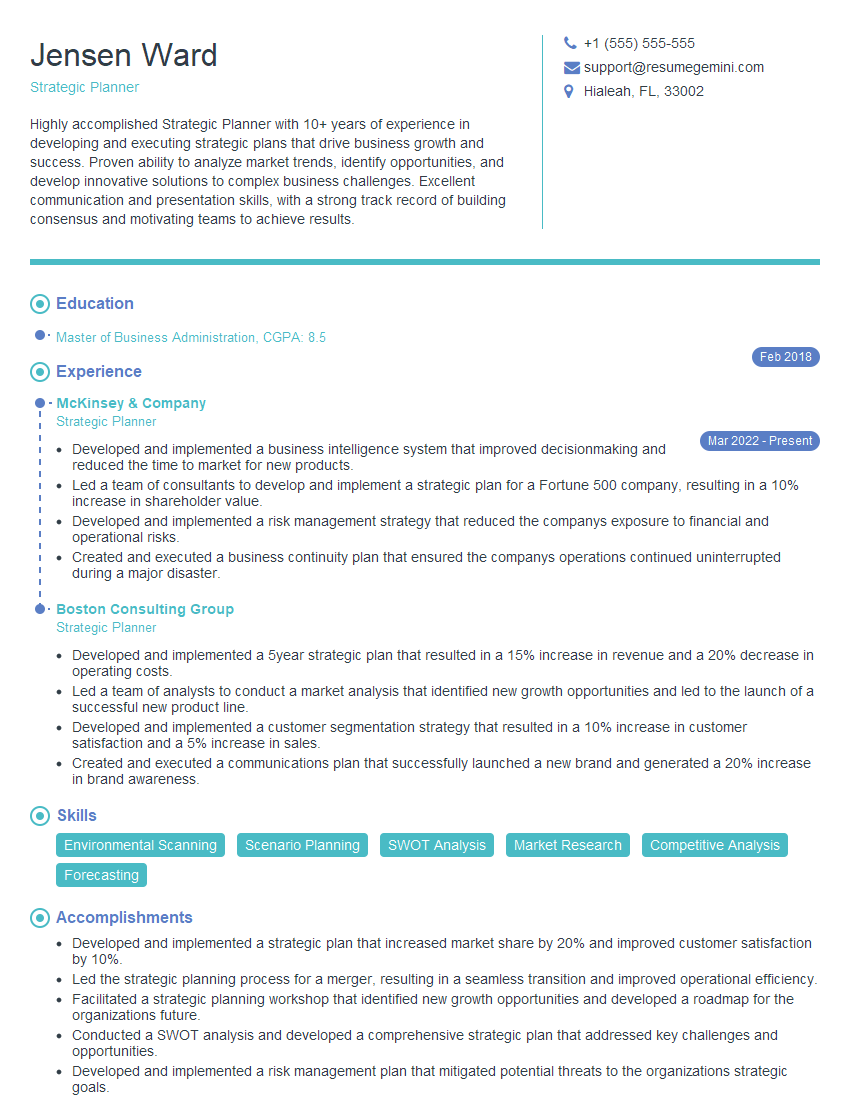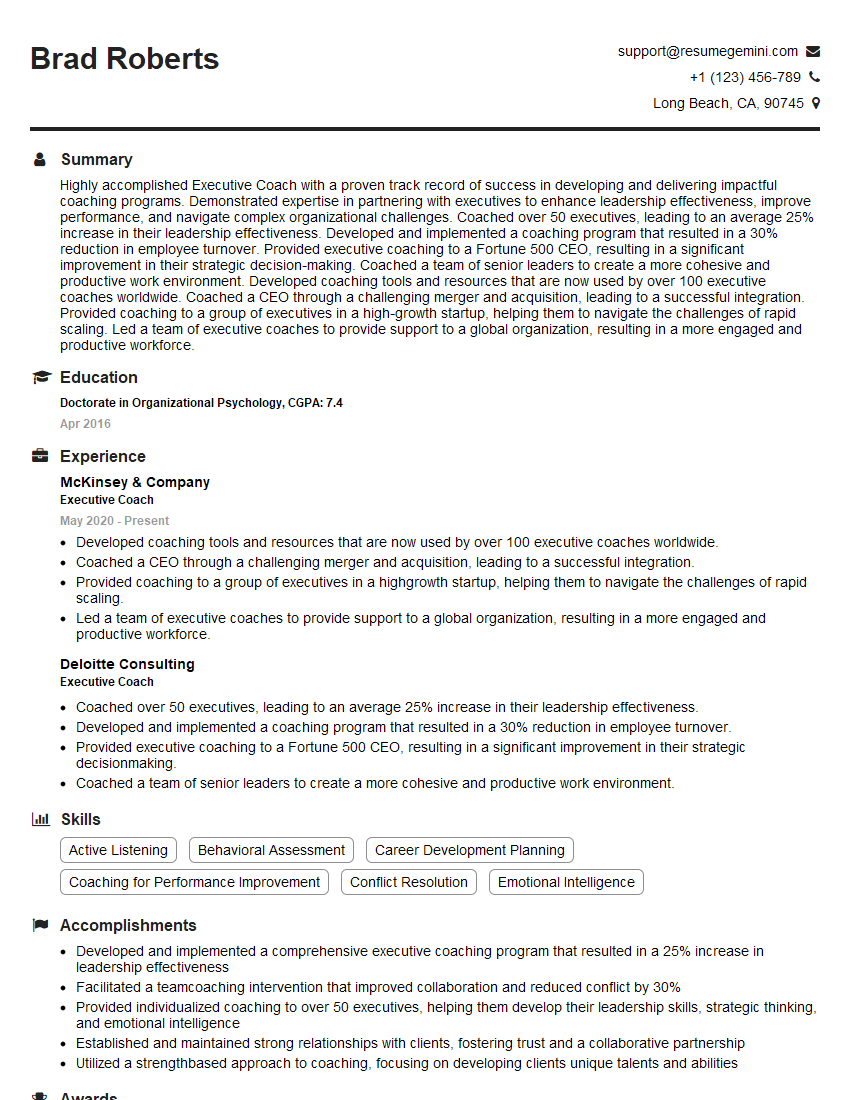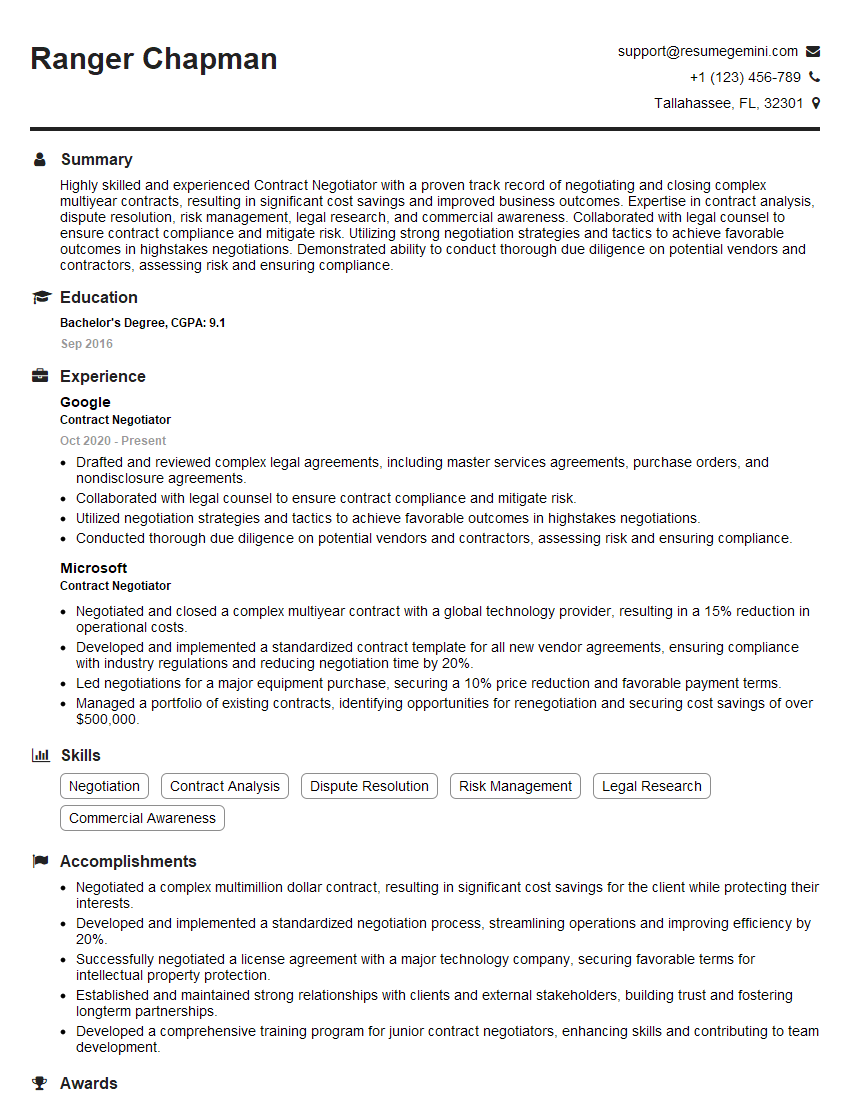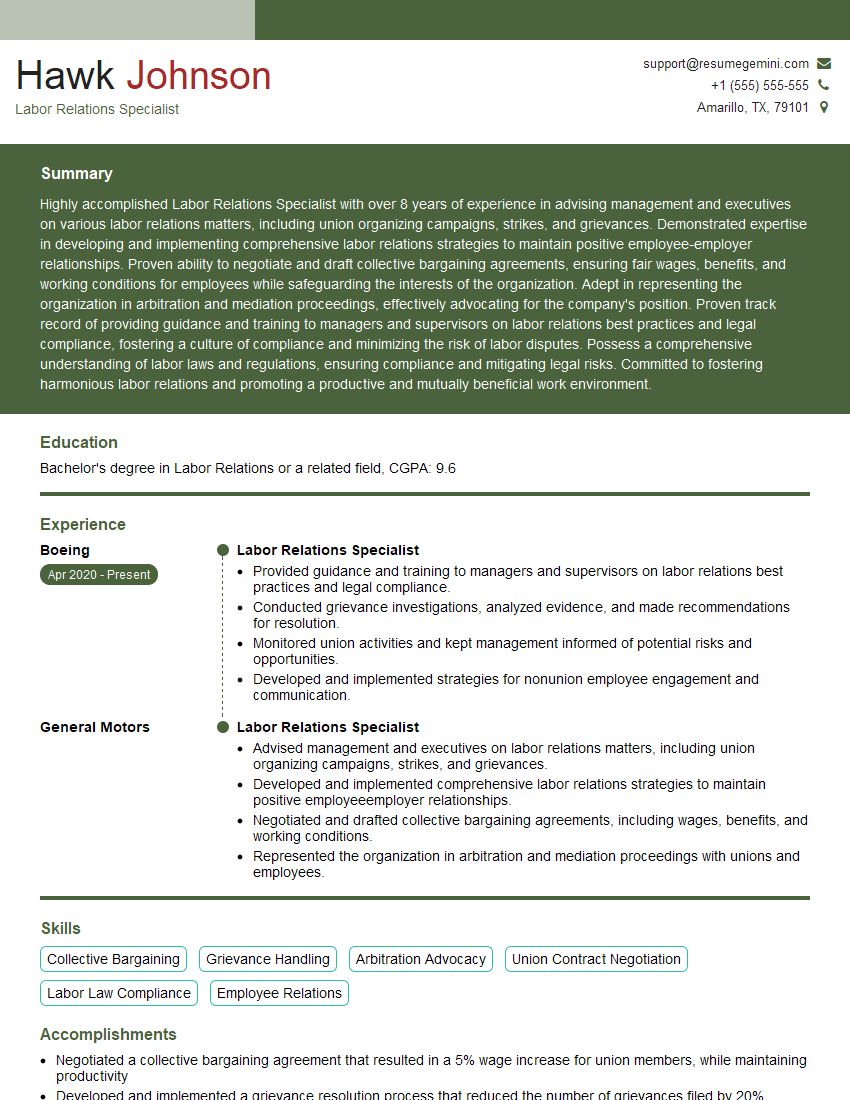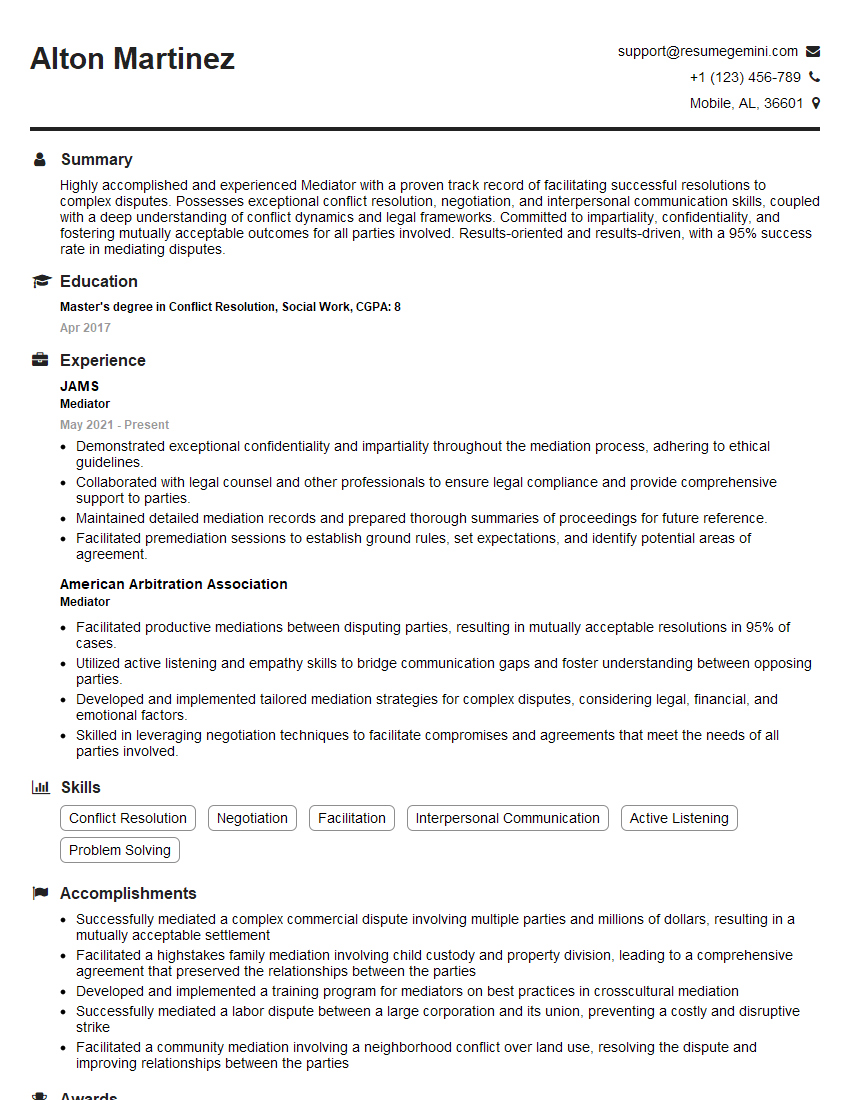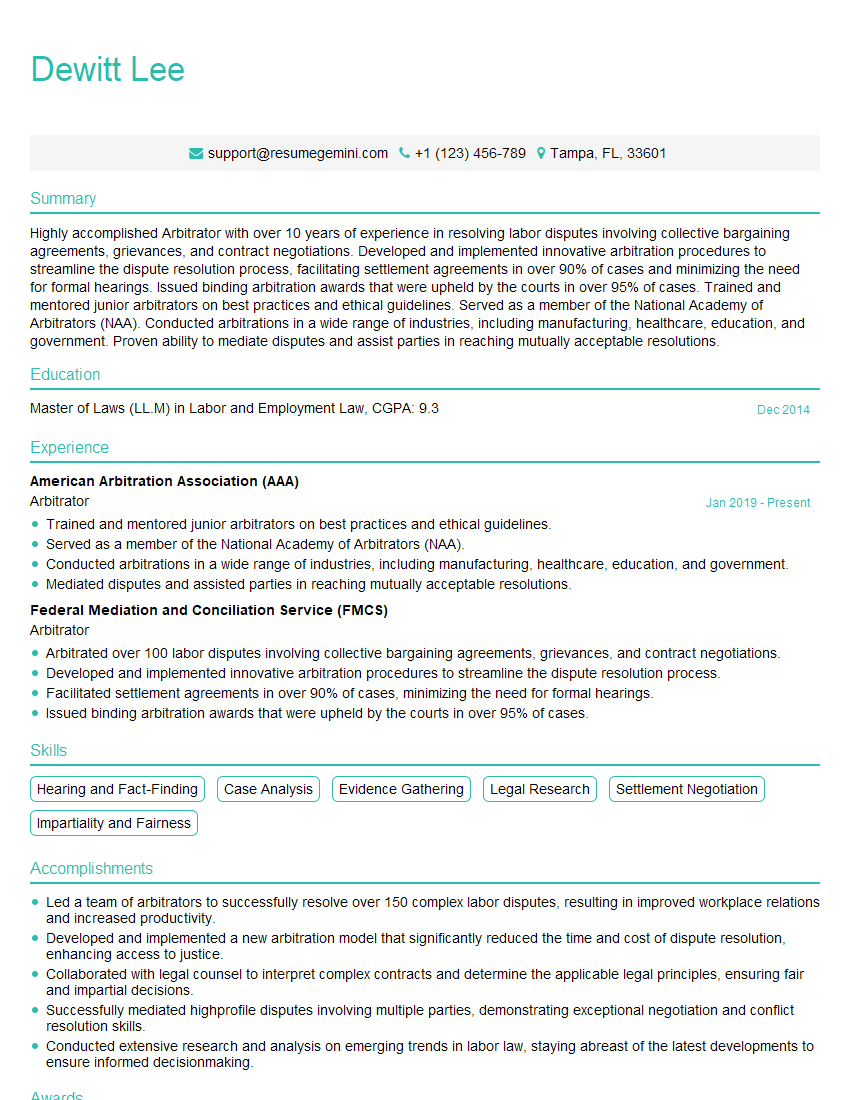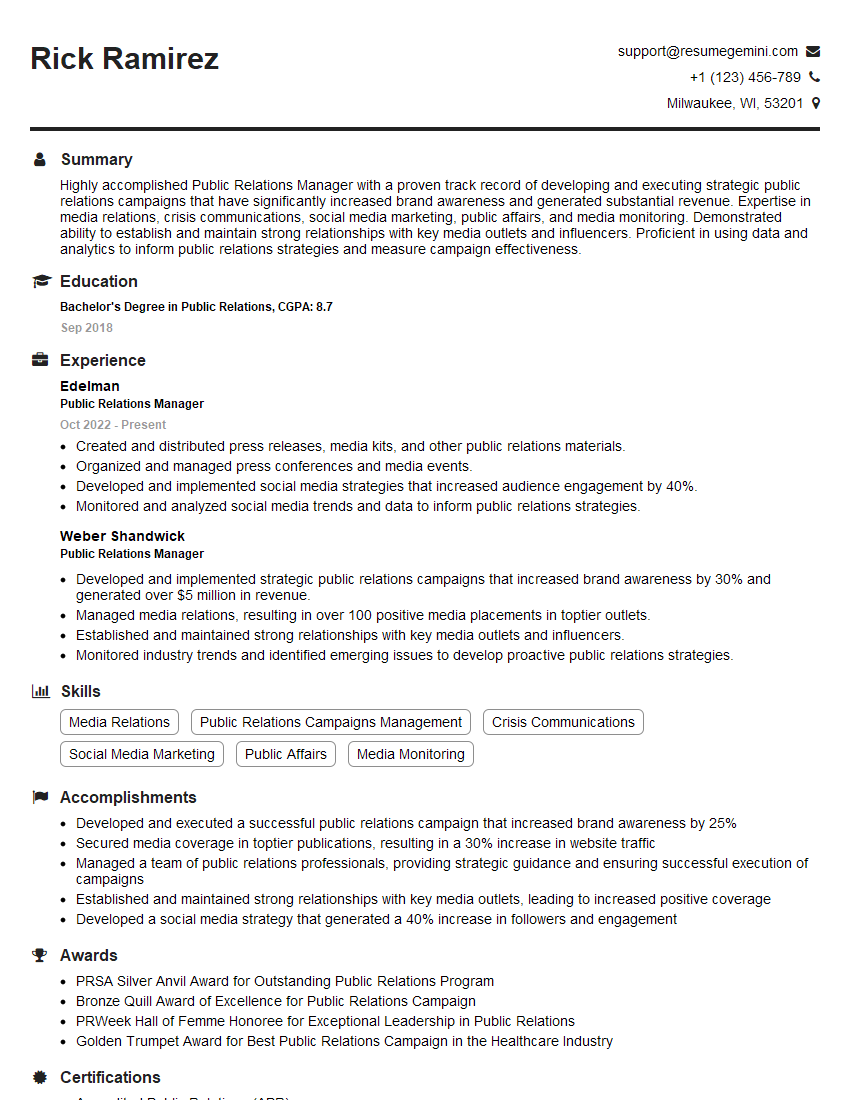Every successful interview starts with knowing what to expect. In this blog, we’ll take you through the top Conflict Resolution and Negotiation Skills interview questions, breaking them down with expert tips to help you deliver impactful answers. Step into your next interview fully prepared and ready to succeed.
Questions Asked in Conflict Resolution and Negotiation Skills Interview
Q 1. Describe your approach to resolving a conflict between two team members with differing work styles.
My approach to resolving conflicts between team members with differing work styles begins with understanding the root cause. It’s rarely about the work styles themselves, but rather the impact those styles have on the team’s effectiveness and the individuals’ feelings of frustration or being undervalued. I facilitate a structured conversation, focusing on active listening and empathy. I start by asking each individual to explain their perspective, their contributions, and the challenges they perceive. Then, I help them identify the specific behaviors that are causing friction, separating the person from the problem. For example, if one team member prefers highly structured tasks and detailed plans while another thrives on flexibility and improvisation, the conflict likely stems from unmet expectations, not inherent personality flaws. We’ll work together to find common ground, perhaps by creating hybrid solutions, establishing clear communication channels, or implementing processes that accommodate both work styles. The goal is not to force conformity, but to create a collaborative environment where each person feels respected and their contributions are valued. This often involves agreeing on shared goals and finding ways for each person to contribute in a way that aligns with their strengths while supporting the overall team objective.
Q 2. Explain the difference between mediation and arbitration.
Mediation and arbitration are both forms of alternative dispute resolution (ADR), but they differ significantly in their approach and outcome. In mediation, a neutral third party (the mediator) facilitates communication between conflicting parties. The mediator doesn’t decide the outcome; instead, they guide the parties toward a mutually agreeable solution. The process emphasizes collaboration and finding common ground. Think of a mediator as a skilled facilitator helping the parties navigate their disagreements and reach a compromise. In arbitration, a neutral third party (the arbitrator) hears evidence and arguments from both sides and then makes a binding decision. This is more like a mini-trial, with the arbitrator acting as a judge. Arbitration is often chosen when parties need a definitive resolution, and they agree in advance to be bound by the arbitrator’s decision.
Q 3. How do you identify the underlying interests in a negotiation?
Identifying underlying interests is crucial for successful negotiation. It involves moving beyond stated positions (what people say they want) to uncover their underlying needs, desires, and concerns. I use several techniques to achieve this. Firstly, I ask open-ended questions, such as “What are your concerns about this situation?” or “What would an ideal outcome look like for you?” This encourages the parties to articulate their deeper needs. Secondly, I actively listen for underlying emotions and motivations, paying close attention to body language and tone of voice. Sometimes, what someone says isn’t the real issue; the underlying feeling might be insecurity, fear of failure, or a need for control. Finally, I use reflective listening, paraphrasing what the parties have said to ensure I understand their interests correctly. For instance, if someone says they want a specific deadline, their underlying interest might be ensuring quality or avoiding a potential penalty. By understanding these underlying interests, I can help the parties find creative solutions that address those needs, leading to a more lasting agreement.
Q 4. What strategies do you employ to build rapport with conflicting parties?
Building rapport is essential for successful conflict resolution and negotiation. It establishes trust and creates an atmosphere conducive to open communication and collaboration. My strategies include: Active listening: Showing genuine interest in the other party’s perspective by paying attention, asking clarifying questions, and summarizing their points. Empathy: Trying to understand the other party’s feelings and perspective, even if I don’t agree with them. Finding common ground: Identifying shared goals, values, or experiences to build a connection. Positive communication: Using a respectful and collaborative tone, focusing on solutions rather than blame. Showing respect: Acknowledging the other party’s contributions and expertise. These strategies help create a safe space for open dialogue, making it more likely that parties will be willing to engage in constructive problem-solving. I also make a conscious effort to understand their communication styles and tailor my own approach to build connection.
Q 5. Describe a situation where you had to negotiate a compromise. What was the outcome?
In a previous role, I was involved in negotiating the allocation of resources between two departments with competing needs. Both departments needed additional staffing, but the budget was limited. One department focused on immediate project deadlines while the other prioritized long-term strategic goals. Initially, the negotiation was tense, with each department advocating for its own needs. To achieve a compromise, I facilitated a brainstorming session where both departments outlined their needs and priorities. We explored various options and found a solution that allocated resources strategically, addressing immediate needs while also supporting long-term goals. We achieved this by implementing a phased approach: allocating some resources immediately to meet pressing deadlines and committing additional resources to the second department once the immediate deadlines were met. The outcome was a solution that satisfied both departments’ key interests, albeit partially. The process was challenging but showed how a collaborative approach and clear prioritization can lead to satisfactory outcomes even with limited resources.
Q 6. How do you handle a negotiation where the other party is being aggressive or uncooperative?
Handling aggressive or uncooperative parties requires a calm and assertive approach. I would start by acknowledging their anger or frustration without validating their behavior. For example, I might say, “I understand you’re feeling frustrated, and I want to help resolve this.” Then, I would attempt to de-escalate the situation by using active listening, focusing on understanding their concerns, and reframing their aggressive statements into more constructive language. If the behavior persists, I might need to set clear boundaries. This could involve reminding them of the purpose of the negotiation, stating that I’m not willing to engage in personal attacks, or pausing the conversation until a more constructive approach can be adopted. In extreme cases, I might involve a neutral third party or suspend the negotiation to prevent further escalation. The goal is always to de-escalate the situation without sacrificing my own integrity or safety. I’ll also try to identify the root cause of their aggression; perhaps they feel they are being treated unfairly or lack trust in the process. Addressing the underlying issue could help resolve the conflict more efficiently.
Q 7. What are some common negotiation tactics and how do you counter them?
Common negotiation tactics include highballing/lowballing (starting with an extreme offer), the good cop/bad cop routine, nibbling (making small requests after an agreement is reached), and the deadline tactic. Countering these tactics requires awareness and a strategy. For highballing/lowballing, I’ll anchor my own offer in market value or relevant data, remaining firm but open to negotiation. For the good cop/bad cop, I remain consistent and professional, refusing to be manipulated by emotion-based tactics. For nibbling, I make it clear that any changes require renegotiation of the initial agreement, maintaining a principled stance. For the deadline tactic, I assess the legitimacy of the deadline and either agree to an extension or remain firm, demonstrating that pressure tactics won’t compromise the overall outcome. My overall strategy is to be well-prepared, know my BATNA (Best Alternative To a Negotiated Agreement), and stay focused on my interests while remaining respectful and open to finding mutually beneficial solutions. I also strive to maintain professionalism and avoid reacting emotionally to manipulative tactics.
Q 8. Explain the concept of ‘BATNA’ (Best Alternative to a Negotiated Agreement).
Your BATNA, or Best Alternative to a Negotiated Agreement, is essentially your fallback plan. It’s the most advantageous alternative course of action you can take if your current negotiation fails. Understanding your BATNA is crucial because it sets your reservation point – the lowest acceptable outcome you’re willing to accept before walking away from the negotiation. A strong BATNA empowers you; a weak BATNA leaves you vulnerable.
Example: Imagine you’re negotiating a salary for a new job. Your BATNA might be your current salary plus a reasonable increase, or another job offer you’ve already received. Knowing this empowers you to walk away from a negotiation that doesn’t meet your minimum requirements. Conversely, if you’re desperate for a job and have no other offers, your BATNA is weak, making you more likely to accept a less favorable offer.
Q 9. How do you assess the power dynamics in a negotiation?
Assessing power dynamics involves understanding the relative strengths and weaknesses of each party involved in a negotiation. This is not simply about who has the most money or authority; it’s a more nuanced assessment. Consider these factors:
- Resources: Who has access to more information, time, financial resources, or alternative options?
- Information: Who possesses crucial knowledge or data relevant to the negotiation?
- Legitimacy: Who has a stronger claim or justification for their position?
- Commitment: How deeply invested are each party in achieving a successful outcome? A highly committed party might be willing to make greater concessions.
- Relationships: Existing relationships, trust, and reputation can significantly influence power dynamics.
Analyzing these factors helps you anticipate the other party’s likely behavior and adjust your strategy accordingly. A negotiator with a strong BATNA and valuable information generally holds more power.
Q 10. Describe a time you had to make a difficult decision that impacted multiple stakeholders.
In a previous role, our team faced a budget shortfall that impacted multiple departments. We needed to decide which projects to cut to stay within budget. This involved stakeholders from marketing, product development, and customer service – each with competing priorities and strong arguments for their funding requests.
My approach involved facilitating a series of collaborative meetings. We used a structured process to rank projects based on their strategic importance, potential return on investment, and impact on various stakeholders. This helped create a transparent and objective process. Although some stakeholders were initially disappointed, the collaborative approach fostered a sense of ownership and helped them accept the difficult decisions. The shared understanding helped to mitigate resentment and maintain positive working relationships across departments despite the budget cuts.
Q 11. How do you manage your emotions during a tense negotiation?
Managing emotions during tense negotiations is paramount. Techniques I employ include:
- Self-awareness: Recognizing my own emotional triggers and how they might affect my judgment and communication.
- Mindfulness: Practicing mindfulness techniques like deep breathing to remain calm and centered. This helps me avoid reacting impulsively.
- Strategic pausing: Taking strategic pauses to avoid immediate responses and to thoughtfully consider my next move. It gives me time to process what is being said, allowing for a more effective response.
- Active listening: Focusing intently on what the other party is saying, rather than formulating my response. This helps me understand their perspective and emotions.
- Emotional regulation: Using self-talk to regulate my emotions and maintain a professional demeanor.
By managing my emotions effectively, I can create a more productive and collaborative negotiation environment.
Q 12. What is your preferred conflict resolution style (e.g., collaborating, compromising, accommodating)?
While I value all conflict resolution styles, my preferred approach is collaborating. This style focuses on finding a win-win solution that addresses the needs and interests of all parties involved. It requires open communication, mutual respect, and a commitment to finding a creative solution that satisfies everyone. While it may take more time and effort, the resulting agreement is often stronger and more sustainable.
However, I adapt my approach depending on the specific context. If a collaborative approach isn’t feasible due to time constraints or conflicting priorities, I may adopt a compromising or accommodating style, prioritizing expediency or maintaining a positive relationship respectively. The key is to choose the style that best serves the situation and the long-term interests of all involved.
Q 13. How do you handle situations where you are unable to reach an agreement?
If an agreement cannot be reached, the next step depends on the situation and the importance of the outcome. This may involve:
- Mediation: Bringing in a neutral third party to help facilitate communication and find common ground.
- Arbitration: Agreeing to let a neutral third party make a binding decision.
- Walking away: If the outcome is not worth the effort or the concessions required, sometimes the best option is to walk away. This is made easier by having a strong BATNA.
- Documenting the impasse: Clearly documenting the points of disagreement and the reasons for the failure to reach an agreement can be useful for future reference or further negotiations.
The most important thing is to maintain respect and professionalism, even if an agreement isn’t reached. Leaving the door open for future possibilities is often wise, as circumstances can change.
Q 14. Explain the importance of active listening in conflict resolution.
Active listening is fundamental in conflict resolution because it allows you to fully understand the other party’s perspective, needs, and concerns. It’s more than simply hearing words; it involves paying close attention to both verbal and nonverbal cues, showing empathy, and demonstrating genuine interest. This helps build rapport, fosters trust, and creates a safe space for open communication.
Examples: Active listening techniques include paraphrasing what the other person says to confirm understanding, asking clarifying questions, reflecting their emotions, and maintaining appropriate nonverbal cues like eye contact and attentive body language. By truly understanding the other party’s perspective, you’re more likely to find common ground and create a mutually acceptable solution. It transforms a confrontational situation into a collaborative one.
Q 15. How do you define success in a negotiation?
Success in negotiation isn’t solely about achieving your initial demands; it’s about achieving a mutually beneficial outcome that satisfies the core interests of all parties involved. It’s about finding a solution that’s both effective and sustainable. A truly successful negotiation leaves all parties feeling respected, understood, and committed to the agreed-upon terms. It’s a win-win, or at least a win-at-least-some-level for everyone, not a zero-sum game where one side’s gain is another’s loss.
For example, in a business merger negotiation, success wouldn’t just be securing the highest possible sale price. It would also involve ensuring a smooth transition, maintaining employee morale, and protecting the long-term value of both companies. This holistic view considers the broader impact and relationships, moving beyond a strictly transactional perspective.
Career Expert Tips:
- Ace those interviews! Prepare effectively by reviewing the Top 50 Most Common Interview Questions on ResumeGemini.
- Navigate your job search with confidence! Explore a wide range of Career Tips on ResumeGemini. Learn about common challenges and recommendations to overcome them.
- Craft the perfect resume! Master the Art of Resume Writing with ResumeGemini’s guide. Showcase your unique qualifications and achievements effectively.
- Don’t miss out on holiday savings! Build your dream resume with ResumeGemini’s ATS optimized templates.
Q 16. What are some ethical considerations in negotiation and conflict resolution?
Ethical considerations are paramount in negotiation and conflict resolution. Maintaining honesty and integrity is crucial. This includes being transparent about your intentions and interests, while also actively listening to and respecting the perspectives of others. Avoid making deceptive or misleading statements, employing manipulative tactics, or exploiting vulnerabilities. Fairness, respect for the law, and a commitment to confidentiality are equally essential. An ethical negotiator prioritizes building trust and fostering collaborative relationships, even when disagreements arise.
For instance, withholding crucial information to gain an advantage, or using coercion or threats, is unethical. Instead, the ethical approach focuses on finding common ground and mutually acceptable solutions through open communication and collaboration. The long-term consequences of unethical behavior often outweigh any short-term gains.
Q 17. Describe your experience using different communication styles in negotiation.
My experience encompasses a range of communication styles, tailored to the specific context and individuals involved. I adapt my approach from direct and assertive to collaborative and empathetic, depending on the situation. In some negotiations, a more direct, problem-solving approach is effective. In others, particularly when dealing with sensitive issues or emotional parties, a more collaborative and empathetic style helps build trust and rapport. I’m skilled in active listening, mirroring, and reframing to ensure clear communication and understanding. I can also utilize more formal communication styles with detailed documentation and minutes when the situation demands a high level of formality and accountability.
For example, when negotiating a contract with a tech startup, a direct and efficient approach might be appropriate. However, mediating a family dispute requires a more sensitive, empathetic style, focusing on emotional intelligence and building trust to facilitate open dialogue.
Q 18. How do you handle conflicting priorities in a negotiation?
Conflicting priorities are common in negotiations. To manage these effectively, I begin by identifying all conflicting interests and the underlying needs they represent. Then, I explore potential trade-offs and compromises, seeking creative solutions that address the core interests of all parties. Prioritization often involves identifying which priorities are most crucial and which can be adjusted or deferred. This might involve ranking priorities based on their relative importance and impact, allowing for some concessions while protecting essential goals. Visual aids like matrices can be helpful in this process.
For example, in a land development negotiation, conflicting priorities might involve environmental concerns versus maximizing profit. A successful outcome might involve incorporating green building practices, creating a park, and reducing the overall development size to address environmental concerns while still achieving a reasonable profit.
Q 19. How do you prioritize different interests in a complex negotiation?
Prioritizing interests in complex negotiations requires a structured approach. I start by identifying all parties involved and their respective interests. This often involves active listening and careful questioning to uncover hidden needs and motivations. Next, I weigh the relative importance of each interest, taking into account factors like urgency, impact, and feasibility. I use tools like weighted scoring matrices to evaluate different options and prioritize accordingly. The goal is to find a solution that satisfies the most important interests of all parties while making reasonable concessions on less critical ones.
For instance, in a multi-stakeholder project, interests might include budget, timeline, quality, and stakeholder satisfaction. A weighted scoring matrix can help determine which elements to prioritize, based on the stakeholders’ relative influence and the project’s overall objectives.
Q 20. Describe your experience documenting the agreements reached in negotiations.
Documenting agreements is a critical aspect of successful negotiation. I consistently maintain thorough records throughout the process. This includes detailed notes from each meeting, outlining key discussions, proposed solutions, concessions, and agreements. After reaching an agreement, I work with all parties to create a comprehensive written document that clearly and unambiguously articulates the terms. This document typically includes a clear definition of responsibilities, timelines, and dispute resolution mechanisms. The document is reviewed and signed by all parties to ensure mutual understanding and commitment.
For example, in a complex commercial contract negotiation, a well-documented agreement minimizes misunderstandings and potential future disputes. This might include annexes specifying technical details, payment schedules, and intellectual property rights. The final contract should be a legally sound and complete record of the agreement.
Q 21. How do you ensure that all parties feel heard and understood during a conflict resolution process?
Ensuring all parties feel heard and understood is essential for effective conflict resolution. This starts with creating a safe and respectful environment where everyone feels comfortable expressing their views without fear of judgment or interruption. I use active listening techniques, such as paraphrasing and summarizing, to demonstrate understanding and validate each person’s perspective. I encourage open dialogue, asking clarifying questions to explore underlying concerns and needs. I ensure that all voices are heard, not just the loudest ones, and find ways to acknowledge the emotional aspects of the conflict.
In practice, this might involve techniques like reflective listening, where you restate the other party’s feelings to show you understand their perspective, even if you don’t agree with them. This helps build rapport and facilitates a more productive conversation. In cases of particularly emotional conflict, separating parties temporarily to allow for calming and individual reflection may be necessary before reconvening to continue the process.
Q 22. How do you deal with a situation where there is a power imbalance between parties involved in a conflict?
Power imbalances significantly complicate conflict resolution. My approach focuses on leveling the playing field, not necessarily making power equal, but ensuring all voices are heard and respected. This involves several strategies:
- Empowering the less powerful party: I actively work to build their confidence and help them articulate their needs clearly. This might involve coaching them before the negotiation or providing them with relevant information.
- Focusing on interests, not positions: Instead of focusing on stated demands (positions), which often reflect power dynamics, I delve into the underlying needs and interests of both parties. This helps to uncover common ground and potential solutions that address everyone’s concerns.
- Mediation and Facilitation: In highly unbalanced situations, I might act as a mediator, ensuring fair process and equal opportunity for expression. This involves actively managing the conversation, ensuring everyone has a chance to speak without interruption, and reframing arguments to find areas of mutual benefit.
- Seeking external support: If necessary, I might involve a neutral third party, like a supervisor or HR representative, to help ensure fairness and prevent coercion. This is especially crucial in cases of potential harassment or abuse of power.
For example, I once worked with a team where a senior manager was consistently overriding junior members’ suggestions. By facilitating open dialogue and highlighting the value of junior team members’ perspectives, I helped shift the power dynamic towards a more collaborative environment. The manager came to understand the benefits of their input and the team improved overall effectiveness.
Q 23. What are some common pitfalls to avoid during a negotiation?
Negotiations can easily go wrong. Some common pitfalls include:
- Focusing solely on your own needs: Neglecting the other party’s perspective often leads to impasses. A win-win outcome is far more sustainable.
- Poor communication: Lack of active listening, unclear articulation, and emotional outbursts derail discussions. Clarity and empathy are key.
- Unrealistic expectations: Going into a negotiation with inflexible demands makes compromise difficult. Be prepared to make concessions.
- Insufficient preparation: Failing to understand the other party’s interests, resources, and potential leverage reduces your chances of success.
- Ignoring BATNA (Best Alternative To a Negotiated Agreement): Having a clear understanding of your alternative options provides valuable leverage and helps set realistic goals.
- Getting emotionally involved: Maintaining objectivity is critical. Allow yourself time to process emotions before and after the negotiation.
For instance, a rushed negotiation without clear objectives can result in an agreement that isn’t beneficial in the long run. Thorough preparation and clear communication prevent this.
Q 24. How do you adapt your negotiation style based on the context and personalities involved?
Adaptability is crucial in negotiation. I tailor my style depending on the context and personalities involved. Some considerations include:
- Personality styles: Some individuals are assertive, others collaborative. Understanding these differences allows me to adjust my communication approach accordingly, for instance, employing a more direct style with assertive individuals and a more collaborative style with less assertive ones.
- Cultural context: Different cultures have different communication norms. Awareness of these helps prevent misinterpretations and enhances understanding.
- Relationship dynamics: Pre-existing relationships impact the negotiation process. A long-term collaborative relationship requires a different approach than a one-off transaction.
- Power dynamics (as discussed earlier): This is crucial; the approach used when dealing with a power imbalance is significantly different from one between equals.
- Time constraints: A high-pressure, time-constrained situation necessitates a different approach than one with ample time for deliberation.
For example, I might use a more formal and structured approach in a business negotiation with a large corporation, whereas a more informal and flexible approach might be suitable for a casual negotiation amongst colleagues.
Q 25. Describe your experience in facilitating group discussions and reaching consensus.
Facilitating group discussions and reaching consensus is a core skill. My experience involves:
- Establishing ground rules: Setting clear expectations for respectful communication, active listening, and participation ensures a productive discussion.
- Active listening and summarizing: I actively listen to diverse viewpoints, paraphrase to ensure understanding, and summarize key points to maintain focus.
- Identifying common ground: I focus on finding areas of agreement to build consensus. This often involves re-framing disagreements to highlight shared interests.
- Managing conflict constructively: I address disagreements promptly and impartially, helping parties to find acceptable compromises.
- Using appropriate techniques: Depending on the group and situation, I might use techniques like brainstorming, nominal group technique, or multi-voting to elicit ideas and achieve consensus.
In a recent project, I facilitated a discussion between several departments with conflicting priorities. By focusing on their shared goal—the successful launch of a product—I guided them to develop a collaborative plan that addressed their individual needs. The consensus reached was far superior to any imposed solution.
Q 26. How do you measure the effectiveness of your conflict resolution strategies?
Measuring the effectiveness of conflict resolution strategies involves both quantitative and qualitative assessments:
- Quantitative measures: This could involve tracking metrics such as the frequency of future conflicts between the involved parties, time taken to resolve disputes, or the cost associated with the conflict.
- Qualitative measures: Gathering feedback from the involved parties is crucial. I usually conduct post-resolution surveys or interviews to assess their satisfaction with the process and outcome, and measure improvements in communication and teamwork.
- Observational analysis: This involves monitoring the interactions between parties post-resolution to gauge improvements in relationship dynamics and collaborative behavior.
In one instance, after mediating a dispute between two teams, I tracked the number of subsequent disagreements over a period of six months. The significant reduction in conflicts, coupled with positive feedback from both teams, served as a quantifiable and qualitative validation of my strategies.
Q 27. How do you stay updated on the best practices in conflict resolution and negotiation?
Staying current is essential in this dynamic field. I achieve this through:
- Professional development: I regularly attend workshops, conferences, and seminars on conflict resolution and negotiation techniques.
- Networking: I actively engage with other professionals in the field, sharing best practices and learning from their experiences.
- Reading professional literature: I regularly read academic journals, books, and industry publications related to conflict resolution and negotiation.
- Online resources: I utilize reputable online resources to stay abreast of the latest research and trends.
Continual learning is critical; the field of conflict resolution is constantly evolving, and staying updated ensures I can provide the most effective solutions.
Q 28. Describe a time you had to manage a conflict with a superior.
I once had a conflict with a superior regarding a project timeline. My proposed timeline was deemed unrealistic by my superior. Rather than directly challenging their authority, I focused on a collaborative approach:
- Active Listening: I carefully listened to their concerns and understood their reasoning behind the more aggressive timeline.
- Data-Driven Argument: I presented data supporting my proposed timeline, highlighting potential risks of rushing the project.
- Compromise and Collaboration: We worked together to find a middle ground that addressed both our concerns. This involved re-prioritizing tasks and identifying areas where the timeline could be adjusted without compromising quality.
- Documenting Agreements: We documented the agreed-upon timeline and responsibilities, thus ensuring clarity and accountability.
The outcome was a revised timeline that was both realistic and acceptable to both of us. This experience reinforced the value of respectful communication, collaborative problem-solving, and the importance of maintaining a professional relationship despite disagreements.
Key Topics to Learn for Conflict Resolution and Negotiation Skills Interview
- Understanding Conflict Styles: Explore various conflict styles (e.g., avoiding, accommodating, competing, compromising, collaborating) and their effectiveness in different situations. Learn to identify your own preferred style and adapt as needed.
- Active Listening and Empathy: Practice techniques for actively listening and demonstrating empathy to understand opposing perspectives. This is crucial for building rapport and finding common ground.
- Effective Communication Strategies: Master clear, concise, and assertive communication. Learn to frame messages positively, manage emotions, and avoid escalating conflict.
- Negotiation Tactics and Strategies: Understand various negotiation approaches (e.g., distributive, integrative) and learn to apply them strategically. Practice techniques for creating value and reaching mutually beneficial agreements.
- Interest-Based Negotiation: Focus on understanding the underlying interests driving each party’s position, rather than just their stated demands. This approach facilitates more creative and lasting solutions.
- Problem-Solving Frameworks: Familiarize yourself with structured problem-solving models that can be applied to conflict resolution situations. This allows for a systematic and logical approach.
- Mediation and Facilitation Skills: Understand the roles and responsibilities of a mediator or facilitator in guiding parties towards a resolution. Practice techniques for managing group dynamics and facilitating productive discussions.
- Ethical Considerations in Conflict Resolution: Explore ethical frameworks and principles that guide decision-making in conflict resolution scenarios. Maintaining integrity and fairness is paramount.
Next Steps
Mastering Conflict Resolution and Negotiation Skills is invaluable for career advancement, opening doors to leadership roles and opportunities requiring strong interpersonal abilities and the capacity to manage challenging situations effectively. A well-crafted resume is your first impression; make it count! Building an ATS-friendly resume significantly improves your chances of getting noticed by recruiters. Leverage ResumeGemini to create a professional, impactful resume that showcases your expertise in Conflict Resolution and Negotiation. ResumeGemini offers examples of resumes tailored to these skills, providing a practical guide to highlighting your qualifications effectively. Take the next step towards your dream career today!
Explore more articles
Users Rating of Our Blogs
Share Your Experience
We value your feedback! Please rate our content and share your thoughts (optional).
What Readers Say About Our Blog
Hello,
We found issues with your domain’s email setup that may be sending your messages to spam or blocking them completely. InboxShield Mini shows you how to fix it in minutes — no tech skills required.
Scan your domain now for details: https://inboxshield-mini.com/
— Adam @ InboxShield Mini
Reply STOP to unsubscribe
Hi, are you owner of interviewgemini.com? What if I told you I could help you find extra time in your schedule, reconnect with leads you didn’t even realize you missed, and bring in more “I want to work with you” conversations, without increasing your ad spend or hiring a full-time employee?
All with a flexible, budget-friendly service that could easily pay for itself. Sounds good?
Would it be nice to jump on a quick 10-minute call so I can show you exactly how we make this work?
Best,
Hapei
Marketing Director
Hey, I know you’re the owner of interviewgemini.com. I’ll be quick.
Fundraising for your business is tough and time-consuming. We make it easier by guaranteeing two private investor meetings each month, for six months. No demos, no pitch events – just direct introductions to active investors matched to your startup.
If youR17;re raising, this could help you build real momentum. Want me to send more info?
Hi, I represent an SEO company that specialises in getting you AI citations and higher rankings on Google. I’d like to offer you a 100% free SEO audit for your website. Would you be interested?
Hi, I represent an SEO company that specialises in getting you AI citations and higher rankings on Google. I’d like to offer you a 100% free SEO audit for your website. Would you be interested?
good
